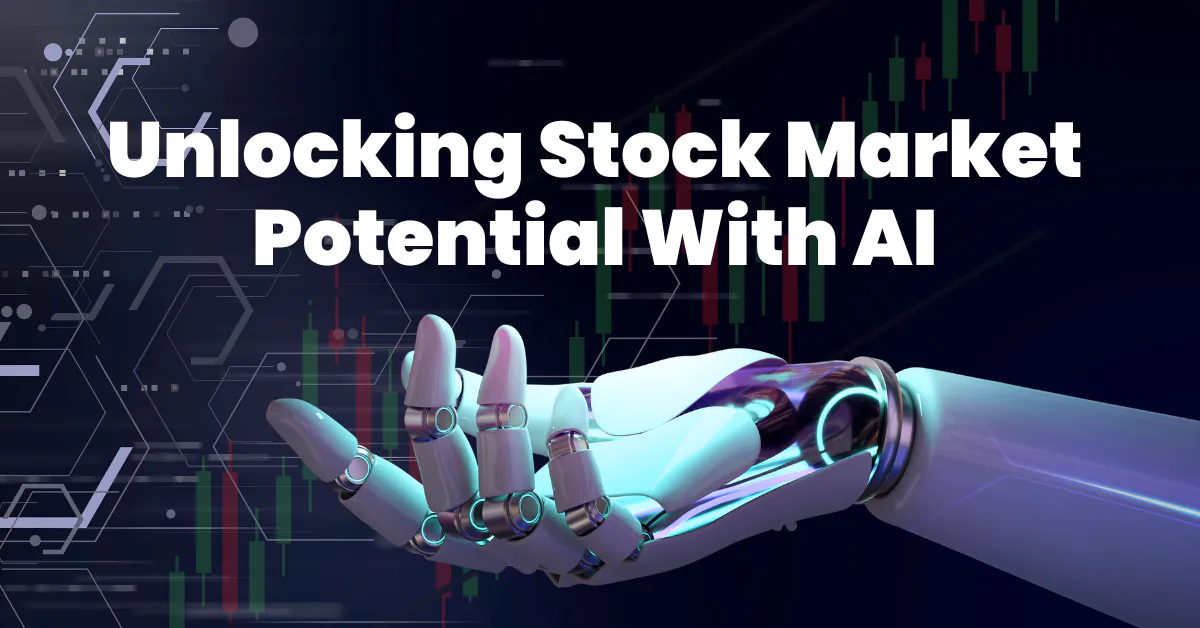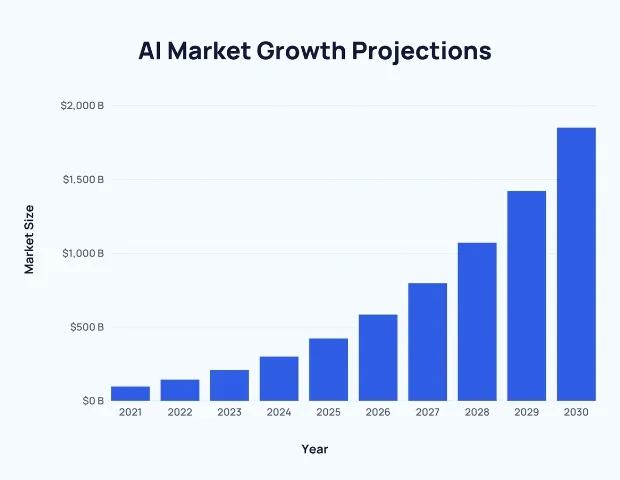Unlocking Stock Market Potential with AI

Daryl Bin, Dealer
Daryl is a securities dealer in the the largest dealing team in Phillip Securities that specialises in Equities, ETFs and CFDs. Prior to joining Phillip Capital, he helped various clients in financial planning in one of the biggest global insurance firm.
During his free time, Daryl enjoys exploring trading strategies to generate new investment ideas.
Introduction of AI
In the world we live in today, artificial intelligence (AI) is almost ubiquitous, transforming all walks in life. As a wide-ranging tool, it enables people to rethink how we integrate information, analyse data, and use the resulting insights to improve decision making. In short, AI is capable of carrying out tasks that typically require human intelligence and has emerged as a pivotal technology in the 21st century, fundamentally transforming industries, economies, and societies with remarkable speed. This may come as a shock to many, but it is widely believed that AI holds the potential to revolutionise almost every aspect of human existence.

Source: Freepik Image [1]
How does AI technology work?
AI technology utilises algorithms, computer programs, and statistical models to enable machines to collect data, process information and recognise patterns to make decisions based on the acquired knowledge. Through this process, AI continuously learns, improves, and evolves to deliver enhanced outcomes.
Benefits of AI:
Efficiency and productivity:
AI automates repetitive tasks, minimising manual labour and enhancing operational efficiency. Businesses can now reallocate their manpower to more complex tasks. AI can be programmed to operate 24/7, resulting in reduced human error and lower costs. For instance, a service provider may implement AI Chat bots on its website to manage customer inquiries. These advanced chatbots are programmed to comprehend and effectively respond to customer feedback.

Source: Freepik Image [1]
Personalised recommendations:
AI leverages user data and behaviour to tailor recommendations uniquely suited to individual preferences. This technology is particularly prevalent in industries such as e-commerce and entertainment.
For example, Netflix, a streaming service that allows users to watch TV shows and movies, deploys AI to track each user’s viewing habits, preferences, and high ratings. Based on this data, it then recommends shows and movies that the user is likely to enjoy.
Safety and security:
AI significantly enhances safety and security across various sectors, including cybersecurity and public safety. It can be programmed to detect anomalies, identify threats and respond to emergencies efficiently. Organisations can deploy AI in cybersecurity to fortify their defence against cyber-attacks. These defence systems utilise algorithms to scan network traffic, spot patterns of malicious behaviour and identify cyber threats. Upon detecting potential threats, they automatically alert the relevant personnel and take proactive measures to mitigate the risk. By implementing AI into their cybersecurity strategies, organisations can boost their cyber defences, prevent data breaches and safeguard their digital assets.
Solving complex problems:
AI algorithms are used to analyse vast amounts of transactional data to identify patterns indicative of fraudulent activities.
AI-driven predictive analytics are also utilised to assess the creditworthiness of loan applicants. By examining an applicant’s financial history, credit score, income and other relevant factors, AI models can predict the likelihood of a loan default. This enables banks to make more accurate lending decisions and manage their credit risk effectively.
Furthermore, banks could deploy AI for risk management and portfolio optimisation. By analysing market data, economic indicators and other relevant factors such as liquidity risk, credit risk and market risk, banks can benefit from making well-informed decisions regarding asset allocation and investment strategies.

Source: Freepik Image [1]
What’s next for the AI market?


Source: AI Market Size [2]
According to the research conducted by Tractica, the AI market is currently experiencing a consistent annual growth rate of 30-40% [2]. From 2021 (market size of US$95.6 billion) to 2024 (market size of US$298.5 billion), there has been a remarkable 312% increase. Forecasts suggest this upward trend will persist, and reach an estimated US$1.85 trillion by 2030, representing an astonishing growth of 519.7%.
In 2024, specific AI-related stocks have shown superior performance:

As illustrated, most of the AI-Stocks in the table shown above have outperformed the Nasdaq and S&P 500. AI technologies are advancing rapidly, driven by ongoing research and development. These advancements are not only broadening the capacities of AI systems but are also creating new opportunities for application across many industries.
Here are some AI-related stocks that we believe will continue to outperform the market due to their involvement in AI:
Crowdstrike Holdings INC ($CRWD)
Crowdstrike (Nasdaq: CRWD), a global cybersecurity leader, has redefined modern security with the world’s most advanced cloud-native platform. This platform excels in protecting critical areas of enterprise risk – endpoints, cloud workloads, identity and data to keep customers ahead of today’s adversaries and prevent data breaches[4].
With the recent shift towards digitalisation, many companies are compelled to adopt technology, yet cybersecurity remains a top concern. In the US, the number of cyberattacks surged to an unprecedented level, surpassing 3200 breaches in 2023 [5]. Consequently, numerous companies have suffered reputation damage, experienced declines in sales revenue, faced legal challenges, and even endangered individual customers. As a result, more companies will seek to prevent cyberattacks from occurring, leading to an increased adoption of AI for identifying and preventing such attacks.
Crowdstrike, for instance, introduced AI-powered Indicators of Attack (IOA) that analyse trillions of data points from its customers and suggest new patterns indicative of breaches. AI-powered IOAs not only excel at detecting malicious activities but also exhibit lower false positives in identifying benign occurrences.
As the AI market continues to grow, companies like Crowdstrike, which specialise in AI-driven cybersecurity solutions, are well positioned to capitalise on this trend. The company has demonstrated strong performance in the past, displaying its ability to innovate and adapt to evolving cybersecurity challenges. With its AI-powered threat detection systems, Crowdstrike can stay ahead of emerging cyber threats and provide effective cybersecurity solutions to its clients. Investors can have confidence in the company’s ability to maintain its momentum and outperform the market, benefiting from the growing demand for AI-driven cybersecurity solutions.
Microsoft Corp ($MSFT)
Microsoft is a US-based company and is currently the largest software company in the world [6]. It develops hardware and provides cloud services. The most recognisable software titles include Microsoft Windows and Office.
Over the years, Microsoft has made significant investments, amounting to billions of dollars in OpenAI [7]. OpenAI is responsible for the creation and progression of ChatGPT, an AI language model designed for natural language understanding and generation tasks. Tailored specifically for conversational interactions, ChatGPT enables users to engage in dialogue with the model as if conversing with another person.

Source: Freepik Image [1]
Microsoft’s dedication to enhancing its technological prowess is evident with its recent investment of a US$1.5 billion strategic investment in G42, an artificial intelligence firm based in the United Arab Emirates (UAE) [8].
Despite its substantial investment in OpenAI, Microsoft remains committed to continually advancing its AI technology. This ongoing commitment suggests that Microsoft will persist in its investments in AI, aiming to maintain a competitive edge in the industry.
Amazon ($AMZN)
Amazon.com, Inc. is an online retailer that offers a wide range of products [9]. The Company products include books, music, computers, electronics, and numerous other products. Amazon offers personalised shopping services, web-based credit card payment, and direct shipping to customers. Amazon also operates a global cloud platform offering extensive services.
For over 25 years, Amazon has extensively leveraged AI to enhance its customer experience. In the past year, Amazon introduced AI-powered features in its physical stores to streamline the shopping process and enhance convenience for its customers. These innovations demonstrate Amazon’s commitment to integrating cutting-edge technology to improve efficiency and customer satisfaction.
How Amazon uses AI
Optimising Supply Chain and Inventory Management:
Amazon integrates AI into its supply chain to optimise warehouse operations and inventory management [10]. By leveraging the prowess of AI, Amazon can predict consumer demand and adjust its inventory management strategies accordingly, ensuring efficiency and reducing waste.
Personalised Product Recommendations:
Amazon utilises AI to offer personalised product recommendations as a strategic marketing approach to enhance sales and maintain customer satisfaction by anticipating their preferences. The objective is to generate recommendations that closely match what users are likely to purchase, thereby anticipating their preferences.
Introducing Rufus – AI-Powered Shopping Assistant:
Recently, Amazon introduced a new AI powered shopping assistant named Rufus, designed to provide customers a conversational shopping experience [11]. Rufus is a generative AI-powered expert shopping assistant, trained on Amazon’s vast product catalogue, customer reviews, community Q&As, and web data. It excels in answering customer questions on various shopping needs and products, offering comparisons, and delivering recommendations based on conversational context.
Rufus can engage in various conversations such as:
- providing product recommendations based on customer preferences and needs
- offering comparisons between different products to help customers make informed decisions
- answering questions about product features, specifications, and availability
- assisting with troubleshooting and providing technical support for products
- guiding customers through the purchasing process, including checkout and payment options
- offering personalised shopping experiences by remembering past interactions and preferences
- providing updates on order status, shipping, and delivery information
- offering assistance with returns, exchanges, and refunds
- providing general information about company policies, promotions, and upcoming events
- engaging customers with entertainment or recommendations for related products or services
Amazon’s commitment to integrating AI technology across its platforms and services positions it as a significant player in the AI sector. With its vast resources and expertise, Amazon is at the forefront of developing innovative AI solutions for various applications, from customer service to supply chain management. As AI technology continues to evolve and play an increasingly integral role in businesses worldwide, Amazon’s dedication to leveraging AI for enhancing its operations makes it a compelling choice for investors looking to capitalise on the growth of AI in the stock market. Therefore, keeping Amazon on your watch list as an AI stock could offer potential opportunities for long-term growth and investment returns.
Conclusion
Given the ongoing advancements in AI technology, we believe that these companies will continue to maintain their competitive edge and outperform the market. They have consistently demonstrated their ability to leverage AI effectively to spur growth, improve operational efficiencies, and enhance customer experiences. It is advisable to monitor these stocks closely and consider adding them to your watch list.
Investors with a higher risk appetite who are seeking to diversify their portfolios may consider Contracts Difference (CFD) to gain exposure to these promising AI-related stocks. CFDs, derivatives traded over-the-counter (OTC), allow investors to take long or short positions for a wide range of asset classes such as stocks, indices, forex (FX), commodities and exchange-traded funds (ETF).
CFDs are traded on margin, allowing investors to open a position by putting up a fraction of the full value of the position. This means that any potential profits or losses will be amplified when you trade CFDs. Hence, it is essential to consider the risks associated with leverage and have an appropriate risk management strategy in place that aligns with your financial goals and risk tolerance.
Learn more about CFD here: https://www.phillipcfd.com/understanding-contract-for-difference-cfd/
To learn more about leverage, you may refer to:
https://www.poems.com.sg/market-journal/the-power-of-leverage-in-cfd/
How to get started with POEMS

POEMS’ award-winning suite of trading platforms offers investors and traders more than 40,000 financial products across global exchanges.
Trade Smarter and Faster
With our newly launched POEMS Mobile 3 Trading App
Explore a myriad of useful features including TradingView chartings to conduct technical analysis with over 100 technical indicators available!
Take this opportunity to expand your trading portfolio with our wide range of products including Stocks, CFDs, ETFs, Unit Trusts and more across 15 global exchanges available for you anytime and anywhere to elevate you as a better trader using our POEMS Mobile 3 App!
For enquiries, please email us at cfd@phillip.com.sg.
References
[2] https://explodingtopics.com/blog/ai-market-size-stats
[3] https://fortune.com/2024/02/22/crowdstrike-ai-cybersecurity-hackers-defenses/
[4]https://www.crowdstrike.com/about-us/
[6] https://techterms.com/definition/microsoft
[8] https://news.crunchbase.com/ai/microsoft-investment-uae-g42/
[9] https://www.bloomberg.com/profile/company/AMZN:US?embedded-checkout=true
[10]https://www.godatafeed.com/blog/how-amazon-uses-ai-to-dominate-ecommerce
More Articles
Playing Defence: Diversification in Forex Trading
Learn how strategic planning and risk management can help you navigate the highs and lows of the forex market. Don’t miss out on unlocking the secrets to long-term profitability!
From Boom to Bust: Lessons from the Barings Bank Collapse
Did you know that the collapse of Barings Bank in 1995 was from massive losses incurred by a rogue trader? Delve into the tale of how Nick Leeson’s fraudulent investments sent shockwaves through the financial world.
Japan's Economic Resurgence – Unveiling the Tailwinds Behind Nikkei 225’s Record Leap
Discover the driving forces behind Japan’s market surge, delve into its economic performance and learn how CFD products can help you navigate the Japanese market’s volatility via our article!
Disclaimer
These commentaries are intended for general circulation and do not have regard to the specific investment objectives, financial situation and particular needs of any person. Accordingly, no warranty whatsoever is given and no liability whatsoever is accepted for any loss arising whether directly or indirectly as a result of any person acting based on this information. You should seek advice from a financial adviser regarding the suitability of any investment product(s) mentioned herein, taking into account your specific investment objectives, financial situation or particular needs, before making a commitment to invest in such products.
Opinions expressed in these commentaries are subject to change without notice. Investments are subject to investment risks including the possible loss of the principal amount invested. The value of units in any fund and the income from them may fall as well as rise. Past performance figures as well as any projection or forecast used in these commentaries are not necessarily indicative of future or likely performance.
Phillip Securities Pte Ltd (PSPL), its directors, connected persons or employees may from time to time have an interest in the financial instruments mentioned in these commentaries.
The information contained in these commentaries has been obtained from public sources which PSPL has no reason to believe are unreliable and any analysis, forecasts, projections, expectations and opinions (collectively the “Research”) contained in these commentaries are based on such information and are expressions of belief only. PSPL has not verified this information and no representation or warranty, express or implied, is made that such information or Research is accurate, complete or verified or should be relied upon as such. Any such information or Research contained in these commentaries are subject to change, and PSPL shall not have any responsibility to maintain the information or Research made available or to supply any corrections, updates or releases in connection therewith. In no event will PSPL be liable for any special, indirect, incidental or consequential damages which may be incurred from the use of the information or Research made available, even if it has been advised of the possibility of such damages. The companies and their employees mentioned in these commentaries cannot be held liable for any errors, inaccuracies and/or omissions howsoever caused. Any opinion or advice herein is made on a general basis and is subject to change without notice. The information provided in these commentaries may contain optimistic statements regarding future events or future financial performance of countries, markets or companies. You must make your own financial assessment of the relevance, accuracy and adequacy of the information provided in these commentaries.
Views and any strategies described in these commentaries may not be suitable for all investors. Opinions expressed herein may differ from the opinions expressed by other units of PSPL or its connected persons and associates. Any reference to or discussion of investment products or commodities in these commentaries is purely for illustrative purposes only and must not be construed as a recommendation, an offer or solicitation for the subscription, purchase or sale of the investment products or commodities mentioned.
This advertisement has not been reviewed by the Monetary Authority of Singapore.








